
Country House Inn and Canonry, Catherine Street
Page updated 27th July 2022
Between the block of 1950s coffee shops and cafes on the south side of Catherine Street and the remains of St Catherine’s Chapel and almshouses is a piece of waste land that has been incorporated into the St Catherine Blitz Memorial. It was on this land that a canonry was constructed in the 13th Century for Canon Reginald le Erceveske, who was implicated in the Walter Lechlade murder of 1283. The canonry had a gatehouse from Catherine Street, a hall, service rooms, bed chambers, a malthouse and stables at the rear. The remains of the kitchen are all that’s left of the canonry, and are part of the ruins of the 'Garden of Rest'. In the 16th Century, the building became the residence of the Cary family, and about 1700, was divided into tenements. The Cary family emblem was a Swan, and ironically, a Swan Inn could be found on the other side of Catherine Street, opposite the canonry, in the 19th Century.
Erceveske or Bickleigh-gate, became St. Catherine's Gate, one of the seven gates around the close. A covenant in an 1814 lease states "give up the chamber over the gate", indicating the position of the gate, which was attached to the front of the canonry. The gate was demolished the same year, making it probable that the inn opened in the building, at this time. The earliest reference to the Country House Inn by name, was from a listing in an 1816 street directory. There is a reference in Jenkins to a chapel at the rear of St Martins Church being converted into a malthouse, and this may be the same as the malthouse that was attached to the inn. Brick alterations were made to the upper floors of the inn during the 18th and 19th Centuries.
The lease of the inn was purchased from the Ecclesiastical Commissioners for £225 by the City Brewery, in February 1878. The freehold was purchased, along with that for 37, 38 and 39 Catherine Street, immediately to the right of the inn, in November 1887, for £1,000. The inn, along with St Catherine's almshouses and chapel were destroyed in the 1942 blitz, after fire spread from building to building. Norman and Pring (City Brewery) sold the site to the city council for £8,000 in 1955. The licence was transferred to the John Bull Inn, at Red Cow Village, which became the Artful Dodger.
Life at the inn
Between the years of 1832 and 1842, the Country House Inn issued 6d tokens which showed the building on the obverse, and men playing billiards on the reverse–it is thought the token was used during billiard competitions. Henry L. Elworthy was landlord of the pub during these years. In 1857, William Roberts was listed as the publican, by Billings Directory.
Local newspapers chart the fortunes of various landlords of the Country House Inn through the 19th-Century. In December 1863, Robert Salter the younger, Licensed Victualler of the inn, was bankrupted, a common end for many landlords – the brewery would just find another. The papers also record the coroners inquest's held at the inn, for nearby deaths. It was also reported that the landlady, Mrs Ann Elworthy was fined £25 for defrauding the revenue by hiding the amount of malt used in brewing beer. In May 1849, the inn came up for sale, or let, in the Flying Post. The description is quite revealing.
THE COUNTRY HOUSE INN,
together with the MALT HOUSE attached thereto, situate in Catherine-street.
The House comprises bar, bar-parlour, breakfast-room, a very large dining-room (known as the Apollo room), tradesman's-room, tap-room, kitchen, scullery, &c., with five, bed-rooms over.
In the court-yard are two spacious cellars, brewhouse, stable, MALT HOUSE and KILN, in good condition, with other requisite offices.
The above House, from its central situation, has commanded, for 30 years past, one of the largest and most respectable trades in this city, and now offers an opportunity rarely to be met with.
Possession may be had at Michaelmas next.
Dated Paris-street, 10th May, 1849.
Within 18 months, the inn was for let again. From 1867, Harry Hems, the ecclesiastical sculptor would invite the poor to an annual Christmas Day dinner. In 1884, he paid for a party of about sixty elderly people to lunch at the Country House Inn, where they enjoyed beef, turkey, a goose and a boars head, followed by plum pudding, mince pies and apple tart. At least two of the party had not missed a dinner for fifteen years.
Destruction in the blitz
The fires of the May 1942 blitz swept through Catherine Street, gutting most of the buildings. James Bell, who was eleven years old, wrote "I remember going into the Chapel, in Catherine Street at 12 noon on the 5th May 1942, walking around and sitting in the pews, There was no sign of the fire which eventually destroyed it - the building next to it was on fire." The block of buildings from next to Oddfellows Hall through to the Country House were hit by incendiary bombs, and the flames spread to St Catherine's Chapel and almshouses.
In February 1955, the land of the inn was purchased by Exeter City Council for £8,000 and the site of the inn and almshouses designated a 'Garden of Rest'. The fireplace and pantry of the kitchen of the Country House Inn are all that remain after more than 800 years of history.
Source: Western Times and Flying Post, Jenkins History of Exeter, Exeter Phoenix by Thomas Sharp and other pages on Exeter Memories.
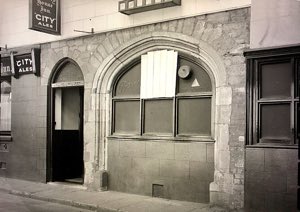 The front of the Country House Inn.
The front of the Country House Inn.
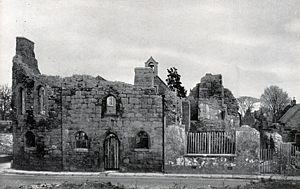 St Catherines Almshouses, left, and the Country House Inn site, right.
St Catherines Almshouses, left, and the Country House Inn site, right.
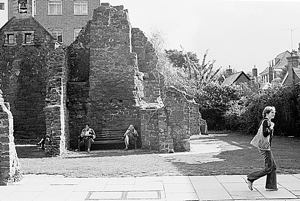 The Garden of Rest in 1979.
The Garden of Rest in 1979.
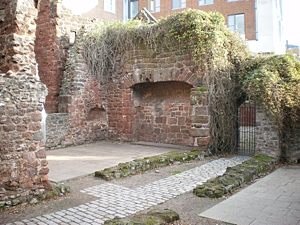 The kitchen area of the Country House Inn.
The kitchen area of the Country House Inn.
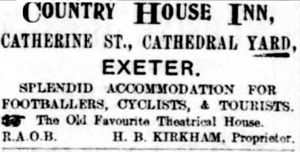 An advert in the Devon and Exeter Gazette, for March 1897, indicates the inn was trying to widen its clientele, including theatre goers.
An advert in the Devon and Exeter Gazette, for March 1897, indicates the inn was trying to widen its clientele, including theatre goers.
│ Top of Page │